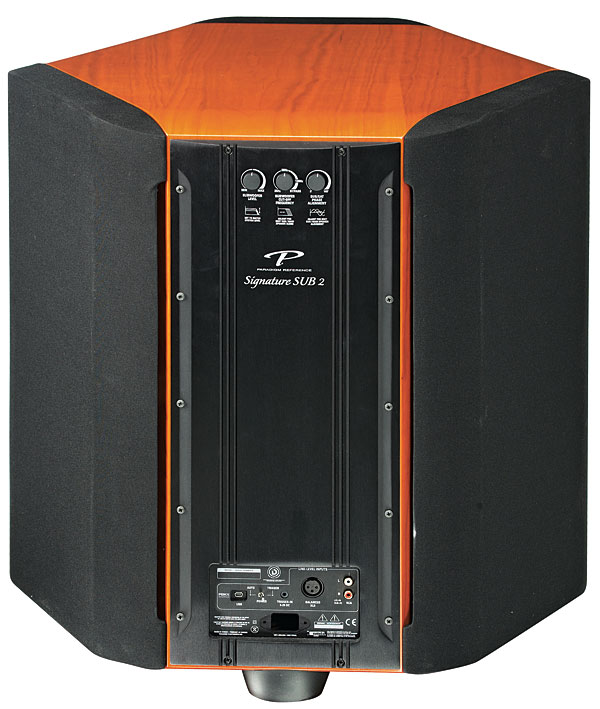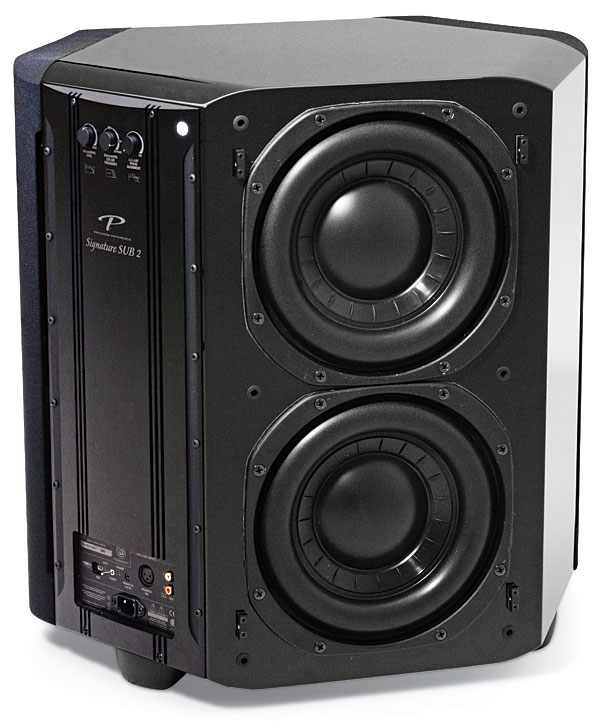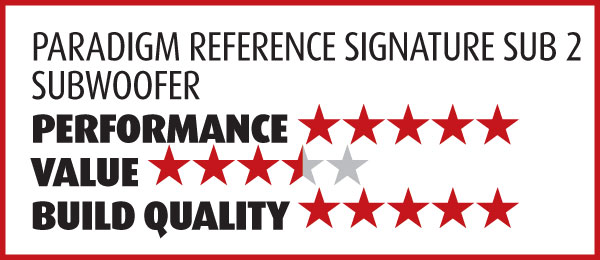Paradigm Reference Signature SUB 2 Subwoofer Page 2
Go Big or Go Home
I have one confession to make up front. Unlike virtually all other speaker and sub reviews in the magazine, the SUB 2 was measured before it was shipped to me, and I was aware of the measurements. As you can see in HT Labs Measures, this sub’s –3-decibel point is a ludicrous 12 hertz. 12 freaking hertz! The measurements came with a note from audio technical editor Mark Peterson. We measure speakers in an automotive bay that we share with the car magazines in our parent company. The room is big enough to house at least a dozen automobiles, trucks, and SUVs and has a ceiling over 15 feet in height. When Mark ran the frequency sweeps, the SUB 2 rattled dust out of the rafters, something that hasn’t happened before or since. Knowing this thing plays really loud, really low in a huge space didn’t prepare me for the way it would energize a small space like my 26-by-17-foot theater room. In spite of its good size, there’s only one spot a sub works in my room: up in the front left corner. With the PBK on my side, plus Paradigm’s recommendation for corner placement, I felt confident I’d get great performance. Man, was I right. But the first thing I had to acknowledge was that I could no longer keep the doors in the back of the room (one to a walk-in closet I use for storing gear, the other to a bathroom) closed during movie nights. The SUB 2 would damn near shake them off their hinges if I didn’t leave them open.

Perhaps more remarkable than the SUB 2’s brute strength is its sense of texture and detail. I had no idea what the hell was going on in those lower frequency ranges. There’s far more nuance in the low frequencies in modern movie soundtracks than I’d have ever believed. In Terminator Salvation in DTS-HD Master Audio, the big-ass terminators are an LFE symphony unto themselves. The tapestry of crushing robotic steps, rocket launches, building demolition, and a really loud and low sonic signature effect for the terminators simply amazes anyone I play it for. And isn’t that a big part of the fun? This is the kind of sub that you’ll love to show off for your friends and neighbors. LFE thump in home theater is like the long ball in baseball; even the chicks dig it.
Equally impressive was how well the SUB 2 kept up with the swift transients in the action that follows as a truck chase turns into a jet fight. The quick punch-in-the-stomach effects in all the various weaponry of The Hurt Locker and many scenes in Robert Zemeckis’ wild A Christmas Carol were extremely tight, punchy, and well defined. Another impressive feat is that, unlike a lot of big thud-pucker subs, you only hear this one when it’s called for. Working with the PBK in conjunction with ARC, I never heard it creep into male vocals or dialogue when I didn’t wish it to. It’s a surprisingly considerate houseguest in that respect. Until it gets loud, low, and intense, it simply does its job unnoticed, which is exactly what a subwoofer should do.
Many nights when the SUB 2 was in my setup, I dug deep into my Blu-ray collection, looking for new challenges in lossless audio. I grabbed some oldies but goodies that dug the deepest and loudest. While the entire movie is a soundtrack showcase, when the alien ships first rise out of the earth in Steven Spielberg’s War of the Worlds remake, the in-room pressure was simply insane, and the scene was that much more ominous. It was physically uncomfortable, but in a good way (I did maintain control of my bodily functions even though it was a struggle). The only aural confusion it created was that, at times, I couldn’t distinguish the movie soundtrack effects from my room and the rest of my house protesting against the immense pressure. I was ducking for cover during the early cannonades in Master and Commander: The Far Side of the World, and Cloverfield woke up my sleeping six-year-old. Time for Dolby Volume to take the edge off.

My Vandersteen 5A main speakers feature their own built-in powered subs. The ARC system measured them but selected a high-ish 60-Hz crossover to the SUB 2. I ignored this and ran them full range. For additional testing, I used the 60-Hz crossover and played multichannel music selections on concert Blu-rays and stereo CDs to hear how the SUB 2 fared. “Vultures” on the Where the Light Is: John Mayer Live in Los Angeles Bluray showed how adept the sealed-cabinet SUB 2 is at maintaining a jumping rhythm and pace as well as very impressive articulation with music. Film scores on CD like Hans Zimmer’s stirring works in Inception and The Dark Knight were more than well served. They were simply stunning, with just the right amount of heft and foundation, but nothing more. Their pacing was surprising only because the SUB 2 can be such a brute when it needs to be.
Conclusion
There are other über-subs out there, and I haven’t heard them all. But over the years I’ve been in this biz, a lot of subs have passed through my room, and I’ve been treated to home theater demos of all kinds all over the world. I’ve never heard a sub that approaches the performance of the Paradigm Reference Signature SUB 2. This is 230 pounds of pure, pulverizing home theater excitement, and it earns my highest recommendation. Unlike other subs, you needn’t worry about whether your associated gear is up to the challenge. With this one, you need to be sure your house is structurally sound enough to withstand it. Why should you spend $9,000 on this behemoth of a powered subwoofer? Because you can.





























































